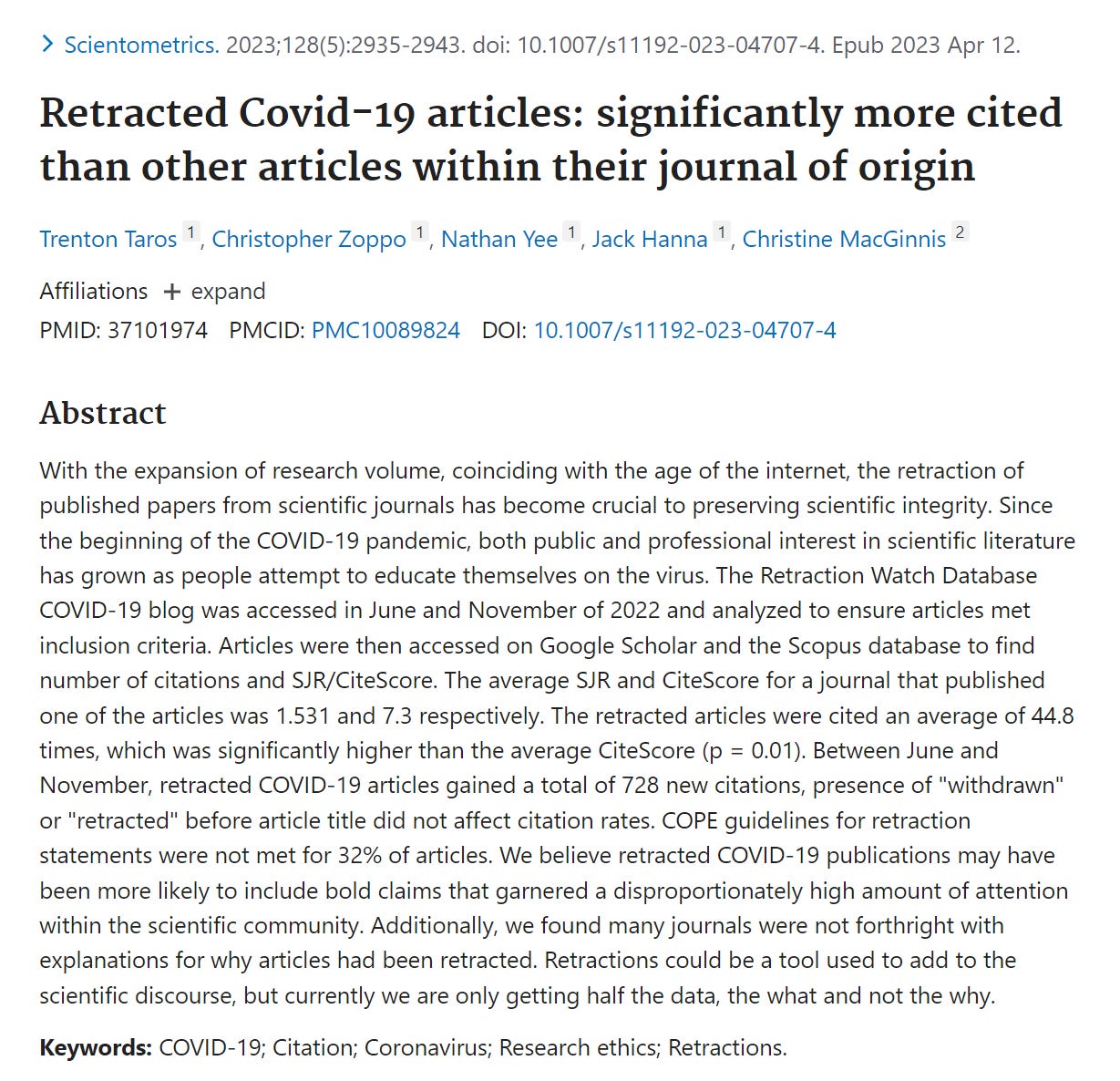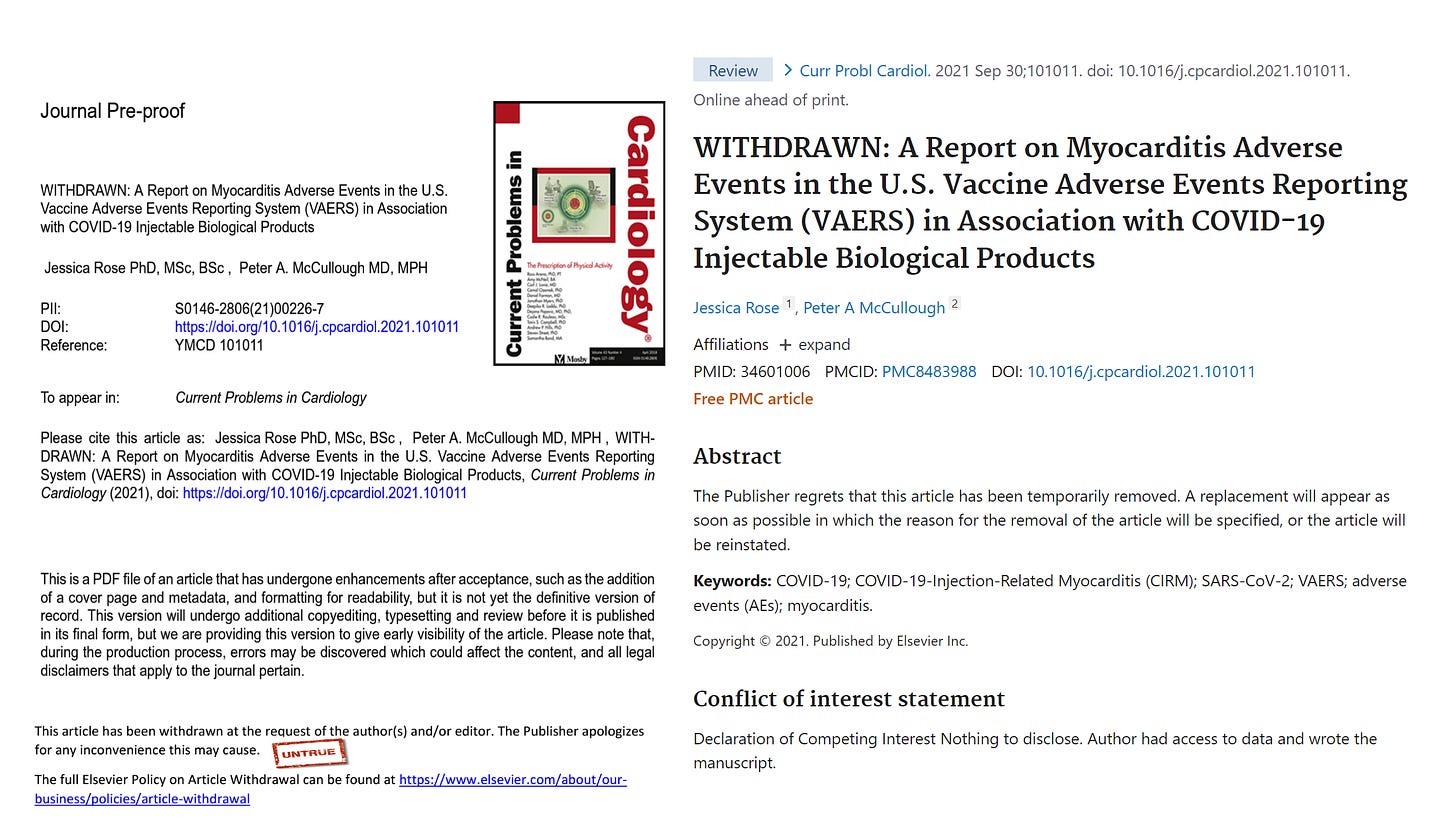Retracted COVID-19 Articles: Significantly More Cited than Others
Biopharmaceutical Complex Censorship Backfiring
By Peter A. McCullough, MD, MPH
I have 685 listings in the National Library of Medicine PUBMED where my academic contributions as a first or contributing author or as a site principle investigator have been memorialized. I am the former longstanding editor Reviews in Cardiovascular Medicine and Cardiorenal Medicine—both are indexed in PUBMED. I have handled thousands of manuscripts and can tell you first hand, historically, that retractions of fully published reports was exceedingly rare. It was only done in the most grievous cases of academic fraud that was discovered after a paper had fully made it through the peer-review process. Since the onset of the crisis, starting with early treatment of COVID-19, we have seen an unprecedented number of papers retracted after full publication and indexing in the National Library of Medicine. As an author and experienced editor, I wanted to understand what is going on in the case of pandemic paper retractions.
The website Science had this post in 2018: “But retractions remain relatively rare: Only about four of every 10,000 papers are now retracted…it has remained level since 2012. In part, that trend reflects a rising denominator: The total number of scientific papers published annually more than doubled from 2003 to 2016.” So among 7 million annual publications there are a few thousand retractions per year—it is indeed very rare. The figure depicts that fraud is a large driver valid retractions and all experts agree the solution is better peer review, vetting, and rejection before publication. Once retracted, papers are typically not cited because the research community does not believe they are valid.
Since the COVID-19 pandemic there has been an explosion of retractions of fully published and copyrighted papers with enough chatter in the academic community to determine the retractions in a few cases are for fraud, such as the 2020 Mehra hydroxychloroquine analysis published in Lancet to intentionally deceive readers into thinking the drug was unsafe and ineffective. Neither of these turned out to be true.
The majority of pandemic papers retracted unfortunately are following a different pattern of valid publication, heavy citation as important contributions, and then pressure exacted on editors/publishers from likely the biopharmaceutical complex (global/federal agencies, NGOs, pharmaceutical companies, conflicted university researchers). Papers are then retracted for “administrative” reasons outside of the the Committee on Publication Ethics (COPE) guideline for journal retractions. COPE states scientific invalidity and fraud should be the principles reasons for retraction.
Taros, and recently reported: “The Retraction Watch Database COVID-19 blog was accessed in June through November of 2022 and analyzed to ensure articles met inclusion criteria. Articles were then accessed on Google Scholar and the Scopus database to find number of citations and SJR/CiteScore. The average SJR and CiteScore for a journal that published one of the articles was 1.531 and 7.3 respectively. The retracted articles were cited an average of 44.8 times, which was significantly higher than the average CiteScore (p = 0.01). Between June and November, retracted COVID-19 articles gained a total of 728 new citations, presence of "withdrawn" or "retracted" before article title did not affect citation rates. COPE guidelines for retraction statements were not met for 32% of articles.”

Taros has confirmed what I have experienced as a co-author of a fully published paper on vaccine safety that was retracted for “administrative” reasons by Current Problems in Cardiology. The journal asked Dr Rose and myself to electively withdraw the paper and we refused. The publisher Elsevier stated to the public authors or editors requested the retraction—it was the editor not the authors.

I believe any paper is targeted that brings hope to patients on early therapy, natural immunity, or reveals failure of government narratives concerning contagion control or vaccine safety. The biopharmaceutical complex uses a variety of measures to coerce editors/publishers to retract manuscripts and remove threats to the “official narrative” depicting the virus is deadly, unassailable, with the only solution being continued mass vaccination.
If you find “Courageous Discourse” enjoyable and useful to your endeavors, please subscribe as a paying or founder member to support our efforts in helping you engage in these discussions with family, friends, and your extended circles.






The rot is so deep in the medical and scientific communities that it seems unlikely that the patient can survive!
Dr. Pete, are you saying that the Ministry of Truth should be renamed the Ministry of Lies? Or that authorities censoring for misinformation should be censored themselves? How many innocents have died or been maimed due to this immoral intellectual corruption?